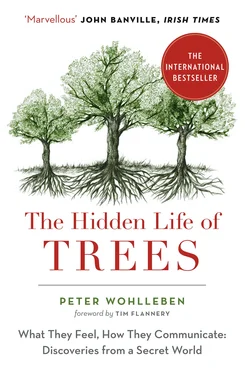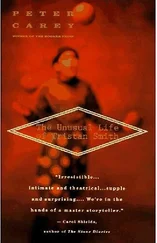It’s a shame you can’t transport entire beeches or oaks into the laboratory to find out more about learning. But, at least as far as water is concerned, there is research in the field that reveals more than just behavioral changes: when trees are really thirsty, they begin to scream. If you’re out in the forest, you won’t be able to hear them, because this all takes place at ultrasonic levels. Scientists at the Swiss Federal Institute for Forest, Snow, and Landscape Research recorded the sounds, and this is how they explain them: Vibrations occur in the trunk when the flow of water from the roots to the leaves is interrupted. This is a purely mechanical event and it probably doesn’t mean anything. 22And yet?
We know how the sounds are produced, and if we were to look through a microscope to examine how humans produce sounds, what we would see wouldn’t be that different: the passage of air down the windpipe causes our vocal cords to vibrate. When I think about the research results, in particular in conjunction with the crackling roots I mentioned earlier, it seems to me that these vibrations could indeed be much more than just vibrations—they could be cries of thirst. The trees might be screaming out a dire warning to their colleagues that water levels are running low.
9
— UNITED WE STAND, —DIVIDED WE FALL
TREES ARE VERY social beings, and they help each other out. But that is not sufficient for successful survival in the forest ecosystem. Every species of tree tries to procure more space for itself, to optimize its performance, and, in this way, to crowd out other species. After the fight for light, it is the fight for water that finally decides who wins. Tree roots are very good at tapping into damp ground and growing fine hairs to increase their surface area so that they can suck up as much water as possible. Under normal circumstances, that is sufficient, but more is always better. And that is why, for millions of years, trees have paired up with fungi.
Fungi are amazing. They don’t really conform to the one-size-fits-all system we use to classify living organisms as either animals or plants. By definition, plants create their own food out of inanimate material, and therefore, they can survive completely independently. It’s no wonder that green vegetation must sprout on barren, empty ground before animals can move in, for animals can survive only if they eat other living things. Incidentally, neither grass nor young trees like it very much when cattle or deer munch on them. Whether it’s a wolf ripping apart a wild boar or a deer eating an oak seedling, in both cases there is pain and death. Fungi are in between animals and plants. Their cell walls are made of chitin—a substance never found in plants—which makes them more like insects. In addition, they cannot photosynthesize and depend on organic connections with other living beings they can feed on.
Over decades, a fungus’s underground cottony web, known as mycelium, expands. There is a honey fungus in Switzerland that covers almost 120 acres and is about a thousand years old. 23Another in Oregon is estimated to be 2,400 years old, extends for 2,000 acres, and weighs 660 tons. 24That makes fungi the largest known living organisms in the world. The two aforementioned giants are not tree friendly; they kill them as they prowl the forest in search of edible tissue. So let’s take a look instead at amicable teamwork between fungi and trees. With the help of mycelium of an appropriate species for each tree—for instance, the oak milkcap and the oak—a tree can greatly increase its functional root surface so that it can suck up considerably more water and nutrients. You find twice the amount of life-giving nitrogen and phosphorus in plants that cooperate with fungal partners than in plants that tap the soil with their roots alone.
To enter into a partnership with one of the many thousands of kinds of fungi, a tree must be very open—literally—because the fungal threads grow into its soft root hairs. There’s no research into whether this is painful or not, but as it is something the tree wants, I imagine it gives rise to positive feelings. However the tree feels, from then on, the two partners work together. The fungus not only penetrates and envelops the tree’s roots, but also allows its web to roam through the surrounding forest floor. In so doing, it extends the reach of the tree’s own roots as the web grows out toward other trees. Here, it connects with other trees’ fungal partners and roots. And so a network is created, and now it’s easy for the trees to exchange vital nutrients (see chapter 3, “Social Security”) and even information—such as an impending insect attack.
This connection makes fungi something like the forest Internet. And such a connection has its price. As we know, these organisms—more like animals in many ways—depend on other species for food. Without a supply of food, they would, quite simply, starve. Therefore, they demand payment in the form of sugar and other carbohydrates, which their partner tree has to deliver. And fungi are not exactly dainty in their requirements. They demand up to a third of the tree’s total food production in return for their services. 25It makes sense, in a situation where you are so dependent on another species, to leave nothing to chance. And so the delicate fibers begin to manipulate the root tips they envelop. First, the fungi listen in on what the tree has to say through its underground structures. Depending on whether that information is useful for them, the fungi begin to produce plant hormones that direct the tree’s cell growth to their advantage. 26
In exchange for the rich sugary reward, the fungi provide a few complimentary benefits for the tree, such as filtering out heavy metals, which are less detrimental to the fungi than to the tree’s roots. These diverted pollutants turn up every fall in the pretty fruiting bodies we bring home in the form of porcini, cèpe, or bolete mushrooms. No wonder radioactive cesium, which was found in soil even before the nuclear reactor disaster in Chernobyl in 1986, is mostly found in mushrooms.
Medical services are also part of the package. The delicate fungal fibers ward off all intruders, including attacks by bacteria or destructive fellow fungi. Together with their trees, fungi can live to be many hundreds of years old, as long as they are healthy. But if conditions in their environment change, for instance, as a result of air pollution, then they breathe their last. Their tree partner, however, does not mourn for long. It wastes no time hooking up with the next species that settles in at its feet. Every tree has multiple options for fungi, and it is only when the last of these passes away that it is really in trouble.
Fungi are much more sensitive. Many species seek out trees that suit them, and once they have reserved them for themselves, they are joined to them for better or for worse. Species that like only birches or larches, for instance, are called “host specific.” Others, such as chanterelles, get along with many different trees: oaks, birches, and spruce. What is important is whether there is still a bit of room underground. And competition is fierce. In oak forests alone, more than a hundred different species of fungi may be present in different parts of the roots of the same tree. From the oaks’ point of view, this is a very practical arrangement. If one fungus drops out because environmental conditions change, the next suitor is already at the door.
Researchers have discovered that fungi also hedge their bets. Dr. Suzanne Simard discovered that their networks are connected not only to a specific tree species but also to trees of different species. 27Simard injected into a birch tree radioactive carbon that moved through the soil and into the fungal network of a neighboring Douglas fir. Although many species of tree fight each other mercilessly above ground and even try to crowd out each other’s root systems, the fungi that populate them seem to be intent on compromise. Whether they actually want to support foreign host trees or only fellow fungi in need of help (which these fungi then pass on to their trees) is as yet unclear.
Читать дальше












